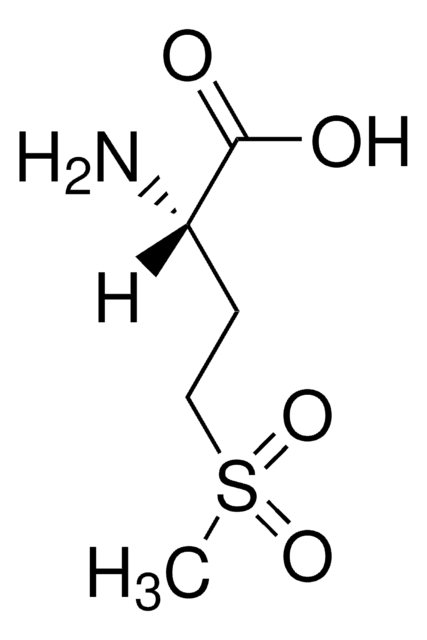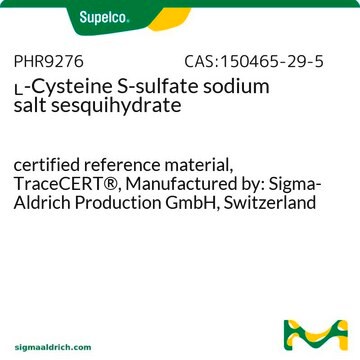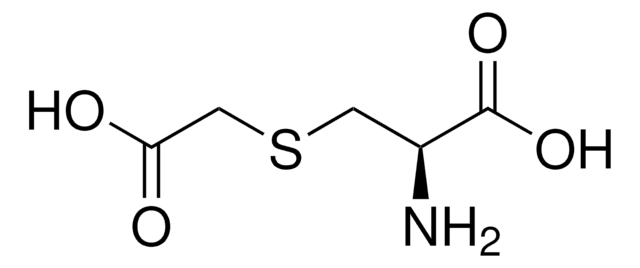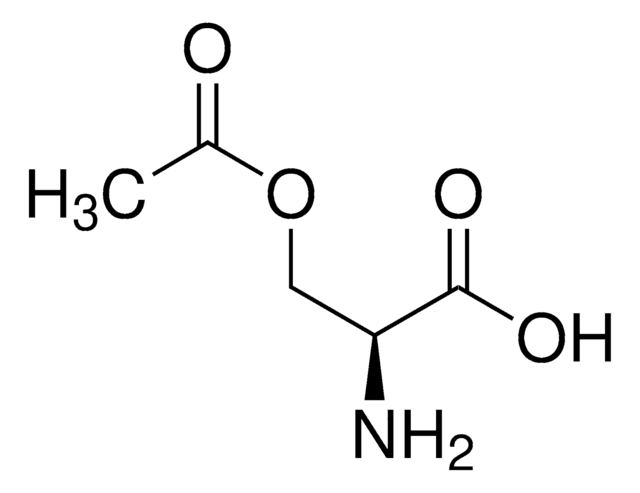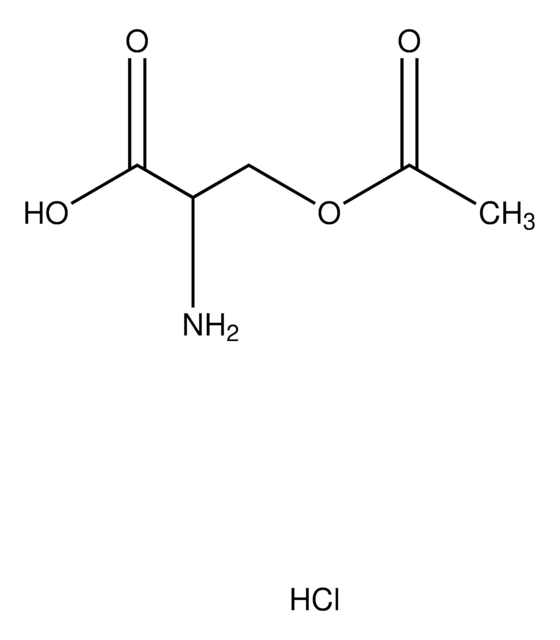추천 제품
제품명
L-Cysteine S-sulfate, ≥98% (TLC)
Quality Level
분석
≥98% (TLC)
양식
powder
기술
ligand binding assay: suitable
색상
white
저장 온도
−20°C
SMILES string
N[C@@H](CSS(O)(=O)=O)C(O)=O
InChI
1S/C3H7NO5S2/c4-2(3(5)6)1-10-11(7,8)9/h2H,1,4H2,(H,5,6)(H,7,8,9)/t2-/m0/s1
InChI key
NOKPBJYHPHHWAN-REOHCLBHSA-N
유사한 제품을 찾으십니까? 방문 제품 비교 안내
생화학적/생리학적 작용
L-Cysteine S-sulfate (LCSS) is used as an NMDA glutamatergic receptor agonist. It serves as a substrate for cystine lyase(s).
Cysteine is one of the functional amino acids that are associated with growth, reproduction, maintenance and immunity. Cysteine is a source of disulfide linkage in protein and is associated with sulfur transport. At physiological pH, cysteine undergoes rapid oxidation to form cystine. Reduced availability of cysteine or cystine, influences leukocyte metabolism. L-Cysteine serves as a precursor for the rate limiting step in glutathione synthesis that occurs in neurons. It donates inorganic sulfate for detoxification reactions. Therefore, L-cysteine might be associated with neuroprotection. It is found to obstruct the entry of heavy metal ions across the blood-brain barrier into the brain. Increased levels of L-cysteine might lead to neurotoxicity.
Cysteine is one of the functional amino acids that are associated with growth, reproduction, maintenance and immunity. Cysteine is a source of disulfide linkage in protein and is associated with sulfur transport. At physiological pH, cysteine undergoes rapid oxidation to form cystine. Reduced availability of cysteine or cystine, influences leukocyte metabolism. L-Cysteine serves as a precursor for the rate limiting step in glutathione synthesis that occurs in neurons. It donates inorganic sulfate for detoxification reactions. Therefore, L-cysteine might be associated with neuroprotection. It is found to obstruct the entry of heavy metal ions across the blood-brain barrier into the brain. Increased levels of L-cysteine might lead to neurotoxicity.
신호어
Warning
유해 및 위험 성명서
Hazard Classifications
Eye Irrit. 2 - Skin Irrit. 2 - STOT SE 3
표적 기관
Respiratory system
Storage Class Code
11 - Combustible Solids
WGK
WGK 3
Flash Point (°F)
Not applicable
Flash Point (°C)
Not applicable
개인 보호 장비
dust mask type N95 (US), Eyeshields, Gloves
가장 최신 버전 중 하나를 선택하세요:
시험 성적서(COA)
Lot/Batch Number
이미 열람한 고객
Takeshi Nakatani et al.
Microbial cell factories, 11, 62-62 (2012-05-23)
Escherichia coli has two L-cysteine biosynthetic pathways; one is synthesized from O-acetyl L-serine (OAS) and sulfate by L-cysteine synthase (CysK), and another is produced via S-sulfocysteine (SSC) from OAS and thiosulfate by SSC synthase (CysM). SSC is converted into L-cysteine
Desensitization of NMDA receptor channels is modulated by glutamate agonists.
Nahum-Levy R
Biophysical Journal, 80(5), 2152-2166 (2001)
E C Ramírez et al.
Journal of agricultural and food chemistry, 47(6), 2218-2225 (2000-05-04)
Cystine lyase is the enzyme responsible for off-aroma deterioration in fresh unblanched broccoli. In this research, cystine lyase purification from broccoli has been optimized. Only one protein peak with cystine lyase activity was found during purification. Broccoli cystine lyase was
R Nahum-Levy et al.
Biophysical journal, 80(5), 2152-2166 (2001-04-28)
Two distinct forms of desensitization have been characterized for N-methyl-D-aspartate (NMDA) receptors. One form results from a weakening of agonist affinity when channels are activated whereas the other form of desensitization results when channels enter a long-lived nonconducting state. A
Studies on analogues of L-cysteine and L-cystine. III. The effect of selenium cystine on leukemia.
WEISBERGER AS and SUHRLAND LG.
Blood, 11(1), 19-30 (1956)
자사의 과학자팀은 생명 과학, 재료 과학, 화학 합성, 크로마토그래피, 분석 및 기타 많은 영역을 포함한 모든 과학 분야에 경험이 있습니다..
고객지원팀으로 연락바랍니다.

